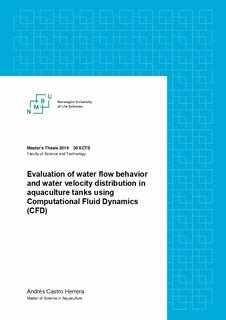| dc.contributor.advisor | Lekang, Odd-Ivar | |
| dc.contributor.author | Castro Herrera, Andres | |
| dc.date.accessioned | 2019-06-24T12:32:19Z | |
| dc.date.available | 2019-06-24T12:32:19Z | |
| dc.date.issued | 2019 | |
| dc.identifier.uri | http://hdl.handle.net/11250/2601896 | |
| dc.description.abstract | The hydrodynamic design of aquaculture tanks is a very complex task where many biological and technological factors should be considered simultaneously. The use of Computational Fluid Dynamics (CFD) is a rapidly expanding technological trend which provides an effective way to evaluate and optimize the hydrodynamic design of aquaculture tanks.
Nevertheless, the study of flow dynamics in aquaculture tanks has until now relied on sophisticated computational tools and time-consuming complex methodologies. This work investigates the use of Flow Simulation as a fully integrated, user-friendly and more economical software alternative for this purpose. By also using simplified simulation settings, the aim is to reduce the human and computational efforts while still achieving reliable flow predictions.
The selected settings and the accuracy of the simulations were validated by replicating the simulation work from two scientific papers; in the papers the authors have validated their CFD simulations against experimental measurements.
A series of experiments were also performed at the university’s aquaculture laboratory in order to further validate the simulation set-up and evaluate the accuracy of the simplified approach. Water velocities were measured at different locations in a fish-rearing tank and compared against the predictions from the CFD simulations. For this experimental validation two different positions of the water inlet pipe were investigated.
Additionally to the main settings, other simulation parameters were also evaluated; such as turbulence properties, meshing strategy, wall roughness and criteria for stopping the calculation process. This was done as variation cases for some of the simulations and provided means for finetuning of the simulation set-up.
It was found that the selected simulation methodology generated satisfactory flow patterns comparable to those of the literature cases studied. The accuracy of the water velocities estimated in the CFD simulations was found to be not as precise as those from the literature validation, but still within the acceptable accuracy thresholds proposed by different scientist in the field.
For one of the validations against the literature, an overall difference in water velocities of around 16% was found between the CFD prognosis and the presented laboratory measurements. The overall relative error of the estimations reported in the paper was of about 7%.
For the other validation against literature, the CFD-estimated water velocities were approximately at two standard deviations of the measured velocities in experiments. The predicted water velocities reported in the paper were close to one standard deviation of the measurements.
It is considered that the simplified methodology on this work should represent a much lesser burden for the creation of representative simulations than the ones presented in literature.
The simplified simulation set-up, while partly sacrificing on accuracy, offers a valuable alternative in terms of the high amount of useful information obtained from the simulations and the reduced computational resources required for their elaboration. | nb_NO |
| dc.language.iso | eng | nb_NO |
| dc.publisher | Norwegian University of Life Sciences, Ås | nb_NO |
| dc.rights | Attribution-NonCommercial-NoDerivatives 4.0 Internasjonal | * |
| dc.rights.uri | http://creativecommons.org/licenses/by-nc-nd/4.0/deed.no | * |
| dc.subject | CFD | nb_NO |
| dc.subject | Aquaculture | nb_NO |
| dc.subject | Hydrodynamics | nb_NO |
| dc.subject | Recirculation Aquaculture System (RAS) | nb_NO |
| dc.subject | Computational Fluid Dynamics (CFD) | nb_NO |
| dc.subject | Flow simulation | nb_NO |
| dc.subject | Turbulence | nb_NO |
| dc.subject | Inlet pipe | nb_NO |
| dc.subject | Inlet nozzle | nb_NO |
| dc.subject | Water velocity | nb_NO |
| dc.subject | Water flow | nb_NO |
| dc.subject | Fish tanks | nb_NO |
| dc.subject | Culture tanks | nb_NO |
| dc.title | Evaluation of water flow behavior and water velocity distribution in aquaculture tanks using Computational Fluid Dynamics (CFD) | nb_NO |
| dc.type | Master thesis | nb_NO |
| dc.description.version | submittedVersion | nb_NO |
| dc.subject.nsi | VDP::Agriculture and fishery disciplines: 900::Fisheries science: 920::Aquaculture: 922 | nb_NO |
| dc.subject.nsi | VDP::Technology: 500::Mechanical engineering: 570::Mechanical and flow technical subjects: 574 | nb_NO |
| dc.source.pagenumber | 162 | nb_NO |
| dc.description.localcode | M-AA | nb_NO |

